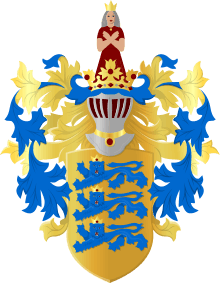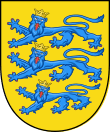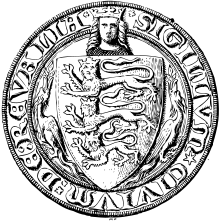Coat of arms of Tallinn
The coat of arms of Tallinn represents the Estonian capital of Tallinn. Tallinn is located in Harju County, Estonia.
| Coat of arms of Tallinn | |
|---|---|
 | |
| Versions | |
 Middle coat of arms of Tallinn | |
.svg.png) Lesser coat of arms of Tallinn | |
| Adopted | 10 October 1996 |
Greater coat of arms
The full coat of arms of Tallinn shows three blue marching, forward-facing (passant gardant) lions crowned with golden crowns on a golden shield. The shield is topped with a silver helmet placed affronté, with closed visor and red lining. The mantling is blue and golden. A golden neck chain featuring a stone hangs around the helmet's neck. The helmet's crest features a golden crown from which a woman protrudes, clad in a red robe and wearing a golden crown, arms crossed before her chest.
- History
The three-lion symbol is one of the oldest Estonian symbols. It has been used since the 13th century and derives from the arms of Danish king Valdemar II, contemporary ruler of Northern Estonia.
Lesser coat of arms
The lesser coat of arms of Tallinn features a silver cross on a red background.
- History
The lesser coat of arms of Tallinn is also the coat of arms of Harju County and depicts the Dannebrog cross.
History
In the Russian Empire
The coat of arms of Reval in the Russian Empire was approved by Catherine II on October 4, 1788, by Law No. 16716 "On the Coats of Arms of the Cities of the Riga, Reval and Vyborg Gubernias and the Olonets Provincial Cities". Description of the arms: in a golden field azure leopard lions.
In 1868, under the direction of B.V. Koen in the Armorial Department of the Heraldry Department of the Government of Senta, a draft of the Reval coat of arms was drawn up in accordance with the rules of external decorations: the shield should have been crowned with a golden-crowned crown; behind the shield probably (??) should be placed anchors, tied with Alexander's ribbon.
On December 10 (22), 1877, the first city assembly was formed, formed during the Zemsky Reform in the Russian Empire in accordance with the Provincial and Provincial Zemstvo Institutions Regulations of 1864 - before that, the Lübeck law was legally valid in the Lower town of Reval. On the same day, the city assembly approved the large coat of arms of Reval. Today December 22 is celebrated as the Day of the City of Tallinn.
Independent Estonia (1918-1940)
In independent Estonia, the coat of arms of Tallinn, in the form approved in 1877, was confirmed in 1919 (in this form it can be seen on the painted bas-relief at the Tallinn Town Hall)
Estonian SSR
From the 1970s to 1980s, a Soviet-style coat of arms for Tallinn, was created by Professor Paul Luhtein. It was a red-blue shield with two transverse waves, on top of which was placed in the middle an image of a golden key with a 5-gang beard and "Old Thomas" in the head.
Gallery
.svg.png) Coat of arms of Tallinn in the Estonian SSR
Coat of arms of Tallinn in the Estonian SSR
Current coat of arms
 Greater version
Greater version Middle version
Middle version.svg.png) Lesser version
Lesser version
References
Sources
- Tallinn sümboolika linna kodulehel (in Estonian)
- Tallinna sümboolika (suur vapp) (in Estonian)
- Tallinna sümboolika (väike vapp) (in Estonian)
- Taani lõvide salapärane tee Eesti vapile (in Estonian)
